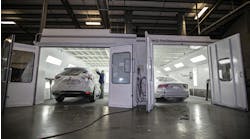Sunroofs never seem to go out of style. Some car, truck and SUV owners just can’t seem to do without the ability to gain a breeze and a little fresh air.
The vast majority of sunroofs (more than 90 percent, manufacturers estimate) are sold with a new vehicle, which enables the buyer to include the cost of the sunroof in the vehicle financing. While many sunroofs are factory-installed, there is a strong aftermarket because vehicle manufacturers don’t offer a factory-installed sunroof for every model. Or sometimes a sunroof-seeking car buyer may want a specific color—but may be unable to find a sunroof-equipped vehicle in that color on the lot.
“There’s quite a learning curve,” notes Jim Stegall, owner of Stegall Auto Accessories in Ridgeland, Miss. “Expect to paint some roofs.” Until a few years ago, Stegall operated a body shop, which also handled custom work such as sunroofs. Eventually he decided to focus only on the custom work. “I got tired of owning a business that the insurance industry told me how to run,” he quips.
Stegall gets most of his sunroof work through car dealers. He has two technicians who focus primarily on sunroof installation and, together, complete an average of three sunroofs a day. The company installs all three of the basic sunroof types—the lowest cost manually operated pop-up models; the mid-range spoiler models, which typically require power and rise up at the rear; and the high-end motorized retractable in-built models.
Body shops can get started installing pop-up or spoiler sunroofs for a relatively small investment. The tools required to install these items, such as precision saws, are among those that a body shop would typically have on hand—and technicians can usually learn how to do an installation by watching a videotape.
After a technician gets proficient, he or she might be able to complete a pop-up sunroof job in an hour, depending on the vehicle model involved. Such jobs usually retail in the range of $200 to $500, with parts and labor of $150 to $350. That means net margins can run in the range of 30 percent or higher—although some car dealers may take a cut, yielding a body shop margin as low as 15 percent to 20 percent. Spoiler-type sunroofs typically retail for between $500 and $800, requiring about two to four hours to complete and yielding similar margin percentages.
Higher end sunroofs are a more significant undertaking. They take longer to complete—in the range of four to six hours, sometimes longer, for a proficient technician—and they retail for around $800 to $1,400. Net margins can be in the range of 30 percent to 40 percent at the retail level, less if the dealer takes a cut.
Manufacturers of higher end sunroofs typically require that technicians receive special training, for which the shop must pay. The shop also may be required to purchase dedicated tools and enough parts for at least a few jobs. Startup costs can easily run $5,000. However, shops planning to aggressively pursue the sunroof business may need to invest substantially more, notes Dave Bosiljevac, co-owner of Executive Motors in Gibsonia, Pa.
“You’ve got to stock a good selection,” Bosiljevac says. “That means an investment of $50,000 to $100,000 if you’re going to do power sunroofs.”
Executive Motors does collision repair and customization—including sunroofs, suspension kits, navigation and other aftermarket equipment—under the same roof. But in many ways, the two businesses operate independently. Each line of business has a dedicated portion of the shop—and although technicians help out as needed, all of them have a specialty.
“Trying to get a body man to do a sunroof is really hard,” says Bosiljevac, who likes to train young technicians whose habits and skills can more easily be molded to fit the unique requirements of sunroof work. “It’s like the difference between a rough carpenter and a finish carpenter, with the sunroof technician being more like the finish carpenter,” adds Bosiljevac.




